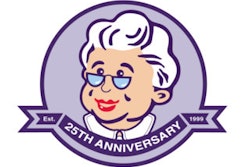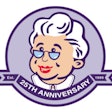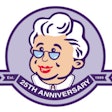
Editor's note: As part of the celebration of AuntMinnie.com's upcoming 25th anniversary, we're presenting 25 for 25 -- a series featuring our most popular content for each of the last 25 years. New articles will be published each Monday until our official anniversary at RSNA 2024. Our top article in 2015 reported on the momentous CMS decision on CT lung cancer screening reimbursement.
In a major victory for individuals at high risk for lung cancer, the U.S. Centers for Medicare and Medicaid Services (CMS) on Thursday released its final decision memo on CT lung cancer screening. The current version contains several changes from last fall's draft decision memo -- smokers may now be screened up to age 77 rather than age 74. And the memo was written with a strong emphasis on facilities maintaining a detailed registry of lung cancer patients.
Lung cancer screening that is reimbursed in full by private payors and Medicare will represent a considerable improvement in U.S. healthcare owing to the vast scope of the disease. More than 220,000 people will be diagnosed with lung cancer this year, and more than 160,000 people will die from it -- "more than breast, colon, and prostate cancers combined," the American College of Radiology (ACR) noted in a statement. "This proven test, and the access to it that Medicare coverage allows, is a game changer in the battle against lung cancer."
The CMS memo approves reimbursement of annual low-dose lung cancer screening for asymptomatic individuals ages 55 to 77 years, who have a tobacco smoking history of at least 30 pack-years (i.e., one pack per day for 30 years). Screening participants must be a current smoker or have quit within the past 15 years.
Reimbursement will require a "written order" for low-dose CT (LDCT) lung cancer screening that must follow a "lung cancer screening and shared decision-making visit furnished by a physician" or a qualified nonphysician practitioner, who may be a physician assistant, nurse practitioner, or clinical nurse specialist, the CMS wrote. Subsequent annual screenings must also be accompanied by a written order obtained from a physician, but these orders may be obtained during "any appropriate visit."
Praise from radiology community
Lung cancer screening advocates were quick to laud the decision to screen thousands of smokers and former smokers at the highest risk of lung cancer.
"Medicare got this right," said Laurie Fenton-Ambrose, president of the screening advocacy group Lung Cancer Alliance, in a statement. "Screening coverage will help save thousands of seniors each year from the nation's leading cancer killer. Screening programs can also help lower smoking rates. Lung cancer screening may even lead to better understanding of addiction as well as lung cancer in those who have never smoked."
"This is a historic moment for us, since it could result in countless lives being saved from the ravages of lung cancer," said Dr. Claudia Henschke, PhD, clinical professor of radiology at the Icahn School of Medicine at Mount Sinai and director of the Lung and Cardiac Screening Program at Mount Sinai Hospital, in an email to AuntMinnie.com. "We will continue our research efforts in optimizing the process of CT screening and the subsequent treatment of early-stage lung cancer: In the meantime, we celebrate this important step."
"This announcement is a remarkable example of how despite many obstacles along the way, researchers, advocacy, and government institutions came together to make the right decision," Dr. David Yankelevitz, professor of radiology at Icahn School of Medicine, told AuntMinnie.com via email. "This decision has the potential to lead to more lives saved from cancer than anything else for the foreseeable future."
Changes from draft memo
Several changes were implemented since the initial draft was proposed last fall, but much remains unchanged.
Higher age bracket
Now patients between the ages of 55 and 77 who have a 30 pack-year history of smoking will be covered, replacing a previous recommendation.
"This new age bracket is still lower than the [U.S. Preventive Services Task Force (USPSTF)] recommendation of patients between the ages of 55 and 80," Dr. Ella Kazerooni, chair of the ACR's Committee on Lung Cancer, wrote in an email to AuntMinnie.com. "Nevertheless, we're still very excited with this change."
The 15-year maximum smoking cessation period remained unchanged, despite ACR advocacy efforts to lengthen it.
Asymptomatic patients
This recommendation was changed to "absence of signs or symptoms of lung cancer," instead of asymptomatic.
Shared decision-making
Patients will only have to complete a shared-decision making/smoking cessation counseling session prior to being referred for their first screening exam. Subsequent screening referrals will not require a shared decision-making session, following a recommendation by ACR.
Dose and accreditation
Changes to the dose threshold allow for adjustments for smaller and larger patients, Kazerooni said, and board certification requirements for radiologists were implemented at the ACR's request.
Finally, facility requirements no longer mandate facility accreditation. "This will facilitate an easier process overall which can be viewed as an inherent positive and not a potential obstacle to access," Kazerooni said.
Documented screening orders
For reimbursement, the written order requirements for screening must contain the beneficiary's date of birth, pack-years smoked, and current smoking status. It must also include a statement that the patient is asymptomatic, along with the National Provider Identifier (NPI) for the order.
Trained readers
CT readers must be board-certified or board-eligible with the American Board of Radiology or other equivalent organization, and they must have been involved in or supervised at least 300 chest CT scans in the past three years, according to the CMS. Readers must have documented participation in continuing medical education and work in a facility that meets imaging faculty criteria.
Screening facility criteria
Low-dose CT screening must be provided with a CT dose index volume (CTDIvol) of 3 mGy or less for standard-sized patients (about 155 lb), with "appropriate" (but unspecified) reductions for smaller patients and increases for larger patients, the CMS stipulated in the memo.
CT screening must utilize a "standardized lung nodule identification, classification, and reporting system," the CMS wrote, and the facility must make smoking cessation interventions available for screening subjects who still smoke.
Finally, the screening facility must collect and submit data to a "CMS-approved registry" for each LDCT lung cancer screening test performed, and the submitted data must include complete patient information and the date of screening.
Registry requirements
CMS-approved registries "must have the capacity and capability to collect data from any Medicare-eligible imaging facility/department that furnishes lung cancer screening with LDCT, with a catchment area that includes all 50 states, U.S. territories, and the District of Columbia," the CMS wrote.
The CMS will review each application for lung cancer registries, which must have a fully developed structure that includes the following:
- Steering committee and governance board for oversight
- Registry management plan, including identification of key personnel
- Operational plan and framework that describes mechanisms for collection and submission of data from imaging facilities to the registry under consideration
- Registry catchment area
- Precise mechanisms for submission of registry data to the CMS electronically
- Mechanisms for collecting information that permit linkage of registry data with external databases
- Description of data management and data quality review methods, including validation
- Use of a CMS-approved standardized data dictionary
- Mechanism for submitting lists of facilities participating in the registry
- Quality assurance plan
ACR noted that CT lung cancer screening is the "first and only cost-effective test" proved to reduce cancer deaths significantly.
"Given the high bar CMS holds in making national coverage determinations, it is clear that the benefits of LDCT scans for those at high risk of lung cancer are indisputable," said Gail Rodriguez, executive director of the Medical Imaging and Technology Alliance (MITA). "This decision comes at an important time in the battle against this devastating disease, as the American Cancer Society recently reported that lung cancer has overcome breast cancer as the No. 1 killer of women in developed countries. Expanding access to this early detection tool is a step in the right direction."



















